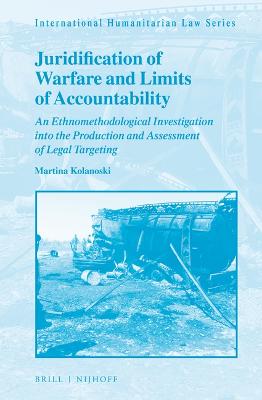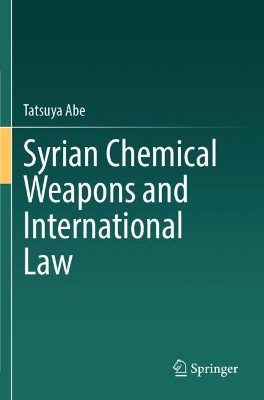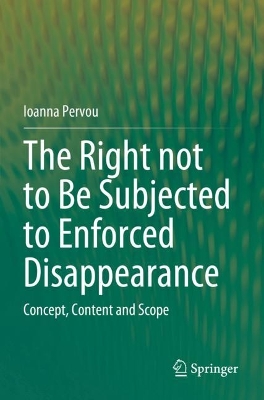Juridification of Warfare and Limits of Accountability
 portes grátis
portes grátis
Juridification of Warfare and Limits of Accountability
An Ethnomethodological Investigation into the Production and Assessment of Legal Targeting
Kolanoski, Martina
Brill
07/2022
196
Dura
Inglês
9789004472433
15 a 20 dias
482
Descrição não disponível.
Abbreviations??
List of Figures and Tables??
Acknowledgements??
1???Introduction??
?1.1?The Juridification of Warfare as an Empirical Phenomenon
?1.1.1?Post-Cold War Developments??
?1.1.2?Civil Law and Victims' Rights to Compensation??
?1.1.3?Relations of War and Law??
?1.1.4?Analysing and Assessing Scenes of Combat??
?1.2?Overview of the Chapters
2???Civilian Deaths and Legal Responsibility??
?2.1?The Kunduz-Airstrike
?2.1.1?Military, Political and Legal Investigations??
?2.1.2?Enduringly Contested Details: Defensive-Offensive Strike??
?2.1.3?Unjustifiable at First Sight??
?2.1.3.1?Scandalisation: The Airstrike as a Turning Point in the National Afghanistan Debate
?2.1.3.2?From Non-War to War: Redefinition of Military Engagement
?2.1.4?Mistakes and Violation of Rules??
?2.2?Knowing Civilians
?2.2.1?Combat(ed) Categorisation: The Colonel's Account??
?2.2.1.1?The Setting
?2.2.1.2?Decision-Making as Mental Process and Categorial Certainty
?2.2.1.3?Correlation of Word and Image: The Video Material as a Telling Source
?2.2.1.4?Auxiliary Collections and Translations
?2.2.1.5?Visible Signs of Taliban and Everyday Performance of Distinction
?2.2.1.6?Errors as Normal Part of Work
?2.2.2?Criminal Investigations??
3???Legal Assessments and the Study of ?Organised Action???
?3.1?Law and Action
?3.1.1?The Home of Law and Motivated Compliance??
?3.1.2?Ethnomethodology: Rules and Situated Sense-Making??
?3.1.3?Law and Categories??
?3.2?Rule-Following in/of Organisations
?3.2.1?Accountability of (Organised) State Action??
?3.3?Procedurally-Organised Work and Procedural Cultures
?3.3.1?Procedural Decision-Making??
?3.3.2?Funnelling and Procedural Cultures??
?3.4?From Object Fromation to Organised Action
?3.4.1?The Co-Structuring Object??
?3.4.2?Organised Action as a Turn in Law/War??
?3.5?Studying Procedural Work
?3.5.1?Two Temporal Orders??
?3.5.2?Discursive Materials in Document-Based Environments??
?3.5.3?tsa? as a Methodological Sensitising Device??
4???Judging Military Action??
?4.1?Studying Court Work
?4.2?Cross-Procedural Turn-Taking: The Civil Lawsuit
?4.2.1?Complaint: The Video Material Evidence against Klein??
?4.2.1.1?Recognition of the Reconstructed Events on the Sandbank
?4.2.1.2?Visible Categories
?4.2.1.3?Careful Average Soldier
?4.2.2?Defence Brief: Interpretative Restraint??
?4.2.3?Hierarchy of Issues??
?4.3?Seeing Like the Military
?4.3.1?Analytic Approaches to the "Military Viewer"??
?4.3.2?Hearing: The Staging of Competence??
?4.3.2.1?What Everyone Can See
?4.3.2.2?The Military Experts
?4.3.2.3?The Afghanistan Expert
?4.3.3?The Military Viewer and His Special Competences: Professional Vision??
?4.4?Military Situation and Legal Significance
?4.4.1?Undoing the Legal Capacity of the Military Object??
?4.4.2?The Subsequent Turns: Preferences within the Viewer's Maxims??
?4.4.2.1?Plaintiffs: Viewer's Maxim of Caution
?4.4.2.2?Court: Viewer's Maxim of Hostility
?4.4.3?Standards of Military Reconnaissance??
?4.5?Constellating Dispute
5???Collaborative Accountability of Legal Targeting??
?5.1?Cohesion and Rule-Following
?5.1.1?Fighting for Precision??
?5.1.2?Precision and Legality as Collaborative Achievement??
?5.2?Data and Research
?5.2.1?The Transcribed Situation and the Process of Target Development??
?5.2.2?Transcript and Process??
?5.3?Collaborating in Targeting
?5.3.1?Audio-Video Material and the Transcript??
?5.3.2?Target Handover??
?5.3.3?Identification Work??
?5.3.4?Work on Open Issues upon Arrival - Business as Usual??
?5.3.4.1?Friendlies: Opening Issue by Standard Procedure
?5.3.4.2?Show of Force: Not Now but Later?
?5.3.4.3?The Drivers: Settled or Open Issue?
?5.3.5?Responding to Developments on the Ground??
?5.3.5.1?New People: Adjustment of the Target
?5.3.5.2?Declaring Target to Be Time-Sensitive
?5.3.6?Pilot Seeking Clarification on Two Issues??
?5.3.6.1?Target Definition
?5.3.6.2?Drivers
?5.3.7?Problem Solving Activities for "RoE Issues"??
?5.3.7.1?In Accordance with RoE: Target Category and Clearance Authority
?5.3.7.2?Show of Force and Target Selection: This Is What We Like to Do
?5.3.7.3?Show of Force and Target Selection: Working with Some RoE Issues
?5.3.7.4?Situation on the Ground
?5.3.8?Switch of Interaction System??
?5.4?Legal Targeting and the Suspension of Doubts
?5.4.1?Disobedience and the (In)Capacity to Know What Is Wrong??
?5.4.2?Funnelling: Working the Temporal Order of Targeting??
?5.4.3?Between "collaborating for precision" and "authoritarian positing"??
6???Conclusions Organised Action ?and the Assessment of Legality???
?6.1?Legal Action Unlimited
?6.2?Members' and Researchers' Analysis of Action
?6.3?Producing Legality
?6.3.1?Neutralising Alternatives??
?6.3.2?Radical Ways of Producing Certainty??
?6.4?The Reproducibility of Assessments
?6.5?Re-Assessing Legal Targeting
?6.5.1?Collaborative Accountability??
?6.5.2?The Legal Capacity of the Target??
?6.6?Progressing Law
Appendix 1???Map Kunduz Area with German Camp and Place of Bombing??
Appendix 2???Redacted Transcript of Cockpit Communication Recorded in One of the F-15 Fighters??
References??
Index???
List of Figures and Tables??
Acknowledgements??
1???Introduction??
?1.1?The Juridification of Warfare as an Empirical Phenomenon
?1.1.1?Post-Cold War Developments??
?1.1.2?Civil Law and Victims' Rights to Compensation??
?1.1.3?Relations of War and Law??
?1.1.4?Analysing and Assessing Scenes of Combat??
?1.2?Overview of the Chapters
2???Civilian Deaths and Legal Responsibility??
?2.1?The Kunduz-Airstrike
?2.1.1?Military, Political and Legal Investigations??
?2.1.2?Enduringly Contested Details: Defensive-Offensive Strike??
?2.1.3?Unjustifiable at First Sight??
?2.1.3.1?Scandalisation: The Airstrike as a Turning Point in the National Afghanistan Debate
?2.1.3.2?From Non-War to War: Redefinition of Military Engagement
?2.1.4?Mistakes and Violation of Rules??
?2.2?Knowing Civilians
?2.2.1?Combat(ed) Categorisation: The Colonel's Account??
?2.2.1.1?The Setting
?2.2.1.2?Decision-Making as Mental Process and Categorial Certainty
?2.2.1.3?Correlation of Word and Image: The Video Material as a Telling Source
?2.2.1.4?Auxiliary Collections and Translations
?2.2.1.5?Visible Signs of Taliban and Everyday Performance of Distinction
?2.2.1.6?Errors as Normal Part of Work
?2.2.2?Criminal Investigations??
3???Legal Assessments and the Study of ?Organised Action???
?3.1?Law and Action
?3.1.1?The Home of Law and Motivated Compliance??
?3.1.2?Ethnomethodology: Rules and Situated Sense-Making??
?3.1.3?Law and Categories??
?3.2?Rule-Following in/of Organisations
?3.2.1?Accountability of (Organised) State Action??
?3.3?Procedurally-Organised Work and Procedural Cultures
?3.3.1?Procedural Decision-Making??
?3.3.2?Funnelling and Procedural Cultures??
?3.4?From Object Fromation to Organised Action
?3.4.1?The Co-Structuring Object??
?3.4.2?Organised Action as a Turn in Law/War??
?3.5?Studying Procedural Work
?3.5.1?Two Temporal Orders??
?3.5.2?Discursive Materials in Document-Based Environments??
?3.5.3?tsa? as a Methodological Sensitising Device??
4???Judging Military Action??
?4.1?Studying Court Work
?4.2?Cross-Procedural Turn-Taking: The Civil Lawsuit
?4.2.1?Complaint: The Video Material Evidence against Klein??
?4.2.1.1?Recognition of the Reconstructed Events on the Sandbank
?4.2.1.2?Visible Categories
?4.2.1.3?Careful Average Soldier
?4.2.2?Defence Brief: Interpretative Restraint??
?4.2.3?Hierarchy of Issues??
?4.3?Seeing Like the Military
?4.3.1?Analytic Approaches to the "Military Viewer"??
?4.3.2?Hearing: The Staging of Competence??
?4.3.2.1?What Everyone Can See
?4.3.2.2?The Military Experts
?4.3.2.3?The Afghanistan Expert
?4.3.3?The Military Viewer and His Special Competences: Professional Vision??
?4.4?Military Situation and Legal Significance
?4.4.1?Undoing the Legal Capacity of the Military Object??
?4.4.2?The Subsequent Turns: Preferences within the Viewer's Maxims??
?4.4.2.1?Plaintiffs: Viewer's Maxim of Caution
?4.4.2.2?Court: Viewer's Maxim of Hostility
?4.4.3?Standards of Military Reconnaissance??
?4.5?Constellating Dispute
5???Collaborative Accountability of Legal Targeting??
?5.1?Cohesion and Rule-Following
?5.1.1?Fighting for Precision??
?5.1.2?Precision and Legality as Collaborative Achievement??
?5.2?Data and Research
?5.2.1?The Transcribed Situation and the Process of Target Development??
?5.2.2?Transcript and Process??
?5.3?Collaborating in Targeting
?5.3.1?Audio-Video Material and the Transcript??
?5.3.2?Target Handover??
?5.3.3?Identification Work??
?5.3.4?Work on Open Issues upon Arrival - Business as Usual??
?5.3.4.1?Friendlies: Opening Issue by Standard Procedure
?5.3.4.2?Show of Force: Not Now but Later?
?5.3.4.3?The Drivers: Settled or Open Issue?
?5.3.5?Responding to Developments on the Ground??
?5.3.5.1?New People: Adjustment of the Target
?5.3.5.2?Declaring Target to Be Time-Sensitive
?5.3.6?Pilot Seeking Clarification on Two Issues??
?5.3.6.1?Target Definition
?5.3.6.2?Drivers
?5.3.7?Problem Solving Activities for "RoE Issues"??
?5.3.7.1?In Accordance with RoE: Target Category and Clearance Authority
?5.3.7.2?Show of Force and Target Selection: This Is What We Like to Do
?5.3.7.3?Show of Force and Target Selection: Working with Some RoE Issues
?5.3.7.4?Situation on the Ground
?5.3.8?Switch of Interaction System??
?5.4?Legal Targeting and the Suspension of Doubts
?5.4.1?Disobedience and the (In)Capacity to Know What Is Wrong??
?5.4.2?Funnelling: Working the Temporal Order of Targeting??
?5.4.3?Between "collaborating for precision" and "authoritarian positing"??
6???Conclusions Organised Action ?and the Assessment of Legality???
?6.1?Legal Action Unlimited
?6.2?Members' and Researchers' Analysis of Action
?6.3?Producing Legality
?6.3.1?Neutralising Alternatives??
?6.3.2?Radical Ways of Producing Certainty??
?6.4?The Reproducibility of Assessments
?6.5?Re-Assessing Legal Targeting
?6.5.1?Collaborative Accountability??
?6.5.2?The Legal Capacity of the Target??
?6.6?Progressing Law
Appendix 1???Map Kunduz Area with German Camp and Place of Bombing??
Appendix 2???Redacted Transcript of Cockpit Communication Recorded in One of the F-15 Fighters??
References??
Index???
Este título pertence ao(s) assunto(s) indicados(s). Para ver outros títulos clique no assunto desejado.
Afghanistan; Bundeswehr; German foreign and security politics; ISAF; Klein; Kunduz-Airstrike; NATO; air war; civilian casualties; precautions in attack; principle of distinction; state violence
Abbreviations??
List of Figures and Tables??
Acknowledgements??
1???Introduction??
?1.1?The Juridification of Warfare as an Empirical Phenomenon
?1.1.1?Post-Cold War Developments??
?1.1.2?Civil Law and Victims' Rights to Compensation??
?1.1.3?Relations of War and Law??
?1.1.4?Analysing and Assessing Scenes of Combat??
?1.2?Overview of the Chapters
2???Civilian Deaths and Legal Responsibility??
?2.1?The Kunduz-Airstrike
?2.1.1?Military, Political and Legal Investigations??
?2.1.2?Enduringly Contested Details: Defensive-Offensive Strike??
?2.1.3?Unjustifiable at First Sight??
?2.1.3.1?Scandalisation: The Airstrike as a Turning Point in the National Afghanistan Debate
?2.1.3.2?From Non-War to War: Redefinition of Military Engagement
?2.1.4?Mistakes and Violation of Rules??
?2.2?Knowing Civilians
?2.2.1?Combat(ed) Categorisation: The Colonel's Account??
?2.2.1.1?The Setting
?2.2.1.2?Decision-Making as Mental Process and Categorial Certainty
?2.2.1.3?Correlation of Word and Image: The Video Material as a Telling Source
?2.2.1.4?Auxiliary Collections and Translations
?2.2.1.5?Visible Signs of Taliban and Everyday Performance of Distinction
?2.2.1.6?Errors as Normal Part of Work
?2.2.2?Criminal Investigations??
3???Legal Assessments and the Study of ?Organised Action???
?3.1?Law and Action
?3.1.1?The Home of Law and Motivated Compliance??
?3.1.2?Ethnomethodology: Rules and Situated Sense-Making??
?3.1.3?Law and Categories??
?3.2?Rule-Following in/of Organisations
?3.2.1?Accountability of (Organised) State Action??
?3.3?Procedurally-Organised Work and Procedural Cultures
?3.3.1?Procedural Decision-Making??
?3.3.2?Funnelling and Procedural Cultures??
?3.4?From Object Fromation to Organised Action
?3.4.1?The Co-Structuring Object??
?3.4.2?Organised Action as a Turn in Law/War??
?3.5?Studying Procedural Work
?3.5.1?Two Temporal Orders??
?3.5.2?Discursive Materials in Document-Based Environments??
?3.5.3?tsa? as a Methodological Sensitising Device??
4???Judging Military Action??
?4.1?Studying Court Work
?4.2?Cross-Procedural Turn-Taking: The Civil Lawsuit
?4.2.1?Complaint: The Video Material Evidence against Klein??
?4.2.1.1?Recognition of the Reconstructed Events on the Sandbank
?4.2.1.2?Visible Categories
?4.2.1.3?Careful Average Soldier
?4.2.2?Defence Brief: Interpretative Restraint??
?4.2.3?Hierarchy of Issues??
?4.3?Seeing Like the Military
?4.3.1?Analytic Approaches to the "Military Viewer"??
?4.3.2?Hearing: The Staging of Competence??
?4.3.2.1?What Everyone Can See
?4.3.2.2?The Military Experts
?4.3.2.3?The Afghanistan Expert
?4.3.3?The Military Viewer and His Special Competences: Professional Vision??
?4.4?Military Situation and Legal Significance
?4.4.1?Undoing the Legal Capacity of the Military Object??
?4.4.2?The Subsequent Turns: Preferences within the Viewer's Maxims??
?4.4.2.1?Plaintiffs: Viewer's Maxim of Caution
?4.4.2.2?Court: Viewer's Maxim of Hostility
?4.4.3?Standards of Military Reconnaissance??
?4.5?Constellating Dispute
5???Collaborative Accountability of Legal Targeting??
?5.1?Cohesion and Rule-Following
?5.1.1?Fighting for Precision??
?5.1.2?Precision and Legality as Collaborative Achievement??
?5.2?Data and Research
?5.2.1?The Transcribed Situation and the Process of Target Development??
?5.2.2?Transcript and Process??
?5.3?Collaborating in Targeting
?5.3.1?Audio-Video Material and the Transcript??
?5.3.2?Target Handover??
?5.3.3?Identification Work??
?5.3.4?Work on Open Issues upon Arrival - Business as Usual??
?5.3.4.1?Friendlies: Opening Issue by Standard Procedure
?5.3.4.2?Show of Force: Not Now but Later?
?5.3.4.3?The Drivers: Settled or Open Issue?
?5.3.5?Responding to Developments on the Ground??
?5.3.5.1?New People: Adjustment of the Target
?5.3.5.2?Declaring Target to Be Time-Sensitive
?5.3.6?Pilot Seeking Clarification on Two Issues??
?5.3.6.1?Target Definition
?5.3.6.2?Drivers
?5.3.7?Problem Solving Activities for "RoE Issues"??
?5.3.7.1?In Accordance with RoE: Target Category and Clearance Authority
?5.3.7.2?Show of Force and Target Selection: This Is What We Like to Do
?5.3.7.3?Show of Force and Target Selection: Working with Some RoE Issues
?5.3.7.4?Situation on the Ground
?5.3.8?Switch of Interaction System??
?5.4?Legal Targeting and the Suspension of Doubts
?5.4.1?Disobedience and the (In)Capacity to Know What Is Wrong??
?5.4.2?Funnelling: Working the Temporal Order of Targeting??
?5.4.3?Between "collaborating for precision" and "authoritarian positing"??
6???Conclusions Organised Action ?and the Assessment of Legality???
?6.1?Legal Action Unlimited
?6.2?Members' and Researchers' Analysis of Action
?6.3?Producing Legality
?6.3.1?Neutralising Alternatives??
?6.3.2?Radical Ways of Producing Certainty??
?6.4?The Reproducibility of Assessments
?6.5?Re-Assessing Legal Targeting
?6.5.1?Collaborative Accountability??
?6.5.2?The Legal Capacity of the Target??
?6.6?Progressing Law
Appendix 1???Map Kunduz Area with German Camp and Place of Bombing??
Appendix 2???Redacted Transcript of Cockpit Communication Recorded in One of the F-15 Fighters??
References??
Index???
List of Figures and Tables??
Acknowledgements??
1???Introduction??
?1.1?The Juridification of Warfare as an Empirical Phenomenon
?1.1.1?Post-Cold War Developments??
?1.1.2?Civil Law and Victims' Rights to Compensation??
?1.1.3?Relations of War and Law??
?1.1.4?Analysing and Assessing Scenes of Combat??
?1.2?Overview of the Chapters
2???Civilian Deaths and Legal Responsibility??
?2.1?The Kunduz-Airstrike
?2.1.1?Military, Political and Legal Investigations??
?2.1.2?Enduringly Contested Details: Defensive-Offensive Strike??
?2.1.3?Unjustifiable at First Sight??
?2.1.3.1?Scandalisation: The Airstrike as a Turning Point in the National Afghanistan Debate
?2.1.3.2?From Non-War to War: Redefinition of Military Engagement
?2.1.4?Mistakes and Violation of Rules??
?2.2?Knowing Civilians
?2.2.1?Combat(ed) Categorisation: The Colonel's Account??
?2.2.1.1?The Setting
?2.2.1.2?Decision-Making as Mental Process and Categorial Certainty
?2.2.1.3?Correlation of Word and Image: The Video Material as a Telling Source
?2.2.1.4?Auxiliary Collections and Translations
?2.2.1.5?Visible Signs of Taliban and Everyday Performance of Distinction
?2.2.1.6?Errors as Normal Part of Work
?2.2.2?Criminal Investigations??
3???Legal Assessments and the Study of ?Organised Action???
?3.1?Law and Action
?3.1.1?The Home of Law and Motivated Compliance??
?3.1.2?Ethnomethodology: Rules and Situated Sense-Making??
?3.1.3?Law and Categories??
?3.2?Rule-Following in/of Organisations
?3.2.1?Accountability of (Organised) State Action??
?3.3?Procedurally-Organised Work and Procedural Cultures
?3.3.1?Procedural Decision-Making??
?3.3.2?Funnelling and Procedural Cultures??
?3.4?From Object Fromation to Organised Action
?3.4.1?The Co-Structuring Object??
?3.4.2?Organised Action as a Turn in Law/War??
?3.5?Studying Procedural Work
?3.5.1?Two Temporal Orders??
?3.5.2?Discursive Materials in Document-Based Environments??
?3.5.3?tsa? as a Methodological Sensitising Device??
4???Judging Military Action??
?4.1?Studying Court Work
?4.2?Cross-Procedural Turn-Taking: The Civil Lawsuit
?4.2.1?Complaint: The Video Material Evidence against Klein??
?4.2.1.1?Recognition of the Reconstructed Events on the Sandbank
?4.2.1.2?Visible Categories
?4.2.1.3?Careful Average Soldier
?4.2.2?Defence Brief: Interpretative Restraint??
?4.2.3?Hierarchy of Issues??
?4.3?Seeing Like the Military
?4.3.1?Analytic Approaches to the "Military Viewer"??
?4.3.2?Hearing: The Staging of Competence??
?4.3.2.1?What Everyone Can See
?4.3.2.2?The Military Experts
?4.3.2.3?The Afghanistan Expert
?4.3.3?The Military Viewer and His Special Competences: Professional Vision??
?4.4?Military Situation and Legal Significance
?4.4.1?Undoing the Legal Capacity of the Military Object??
?4.4.2?The Subsequent Turns: Preferences within the Viewer's Maxims??
?4.4.2.1?Plaintiffs: Viewer's Maxim of Caution
?4.4.2.2?Court: Viewer's Maxim of Hostility
?4.4.3?Standards of Military Reconnaissance??
?4.5?Constellating Dispute
5???Collaborative Accountability of Legal Targeting??
?5.1?Cohesion and Rule-Following
?5.1.1?Fighting for Precision??
?5.1.2?Precision and Legality as Collaborative Achievement??
?5.2?Data and Research
?5.2.1?The Transcribed Situation and the Process of Target Development??
?5.2.2?Transcript and Process??
?5.3?Collaborating in Targeting
?5.3.1?Audio-Video Material and the Transcript??
?5.3.2?Target Handover??
?5.3.3?Identification Work??
?5.3.4?Work on Open Issues upon Arrival - Business as Usual??
?5.3.4.1?Friendlies: Opening Issue by Standard Procedure
?5.3.4.2?Show of Force: Not Now but Later?
?5.3.4.3?The Drivers: Settled or Open Issue?
?5.3.5?Responding to Developments on the Ground??
?5.3.5.1?New People: Adjustment of the Target
?5.3.5.2?Declaring Target to Be Time-Sensitive
?5.3.6?Pilot Seeking Clarification on Two Issues??
?5.3.6.1?Target Definition
?5.3.6.2?Drivers
?5.3.7?Problem Solving Activities for "RoE Issues"??
?5.3.7.1?In Accordance with RoE: Target Category and Clearance Authority
?5.3.7.2?Show of Force and Target Selection: This Is What We Like to Do
?5.3.7.3?Show of Force and Target Selection: Working with Some RoE Issues
?5.3.7.4?Situation on the Ground
?5.3.8?Switch of Interaction System??
?5.4?Legal Targeting and the Suspension of Doubts
?5.4.1?Disobedience and the (In)Capacity to Know What Is Wrong??
?5.4.2?Funnelling: Working the Temporal Order of Targeting??
?5.4.3?Between "collaborating for precision" and "authoritarian positing"??
6???Conclusions Organised Action ?and the Assessment of Legality???
?6.1?Legal Action Unlimited
?6.2?Members' and Researchers' Analysis of Action
?6.3?Producing Legality
?6.3.1?Neutralising Alternatives??
?6.3.2?Radical Ways of Producing Certainty??
?6.4?The Reproducibility of Assessments
?6.5?Re-Assessing Legal Targeting
?6.5.1?Collaborative Accountability??
?6.5.2?The Legal Capacity of the Target??
?6.6?Progressing Law
Appendix 1???Map Kunduz Area with German Camp and Place of Bombing??
Appendix 2???Redacted Transcript of Cockpit Communication Recorded in One of the F-15 Fighters??
References??
Index???
Este título pertence ao(s) assunto(s) indicados(s). Para ver outros títulos clique no assunto desejado.







